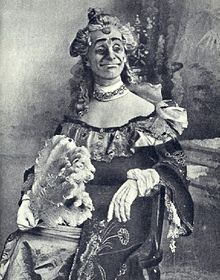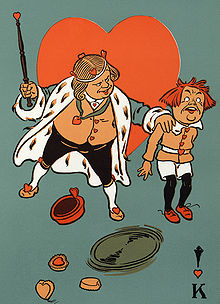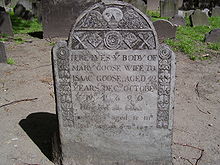- Mother Goose
-
This article is about the fairy tale character. For other uses, see Mother Goose (disambiguation).
 A page from a late 17th century handwritten and illustrated version of Charles Perrault's Contes de ma mère l'Oye, depicting Puss in Boots
A page from a late 17th century handwritten and illustrated version of Charles Perrault's Contes de ma mère l'Oye, depicting Puss in Boots
The familiar figure of Mother Goose is an imaginary author of a collection of fairy tales and nursery rhymes[1] which are often published as Mother Goose Rhymes. As a character, she appears in one "nursery rhyme".[2] A Christmas pantomime called Mother Goose is often performed in the United Kingdom. The so-called "Mother Goose" rhymes and stories have formed the basis for many classic British pantomimes. Mother Goose is generally depicted in literature and book illustration as an elderly country woman in a tall hat and shawl, a costume identical to the peasant costume worn in Wales in the early 20th century, but is sometimes depicted as a goose (usually wearing a bonnet).
Contents
Identity
Mother Goose is the name given to an archetypal country woman. English readers were familiar with Mother Hubbard, already a stock figure when Edmund Spenser published his satire "Mother Hubbard's tale", 1590; with the superstitious advice on getting a husband or a wife of "Mother Bunch", who was credited with the fairy stories of Madame d'Aulnoy when they first appeared in English.[3] Mother Goose is credited with the Mother Goose stories and rhymes; yet no specific writer has ever been identified with such a name. An early mention appears in an aside in a versified chronicle of weekly happenings that appeared regularly for several years, Jean Loret's La Muse Historique, collected in 1650.[4] His remark, ...comme un conte de la Mère Oye ("...like a Mother Goose story") shows that the term was already familiar.
Other references to "mère l'oye" or "mère oye" occur in earlier French writings. A compilation of satires published in 1626 mentions "un conte d'Urgande et de ma mère l'Oye," (Les satyres de Saint-Regnier). Guy de la Brosse, in his 1628 work De la nature, vertu et utilite de plantes, mentions "contes de la mère oye." And in Pieces Curieuses en suite de celles du Sieur de St. Germain, a piece written in 1638 reads "... tout ce que je fais imprimer dans mes Gazettes passe desormais pour des contes de ma mère l'oye, et des fables du moisne Bourry pour amuser le peuple... ." A side note reads: "Dont l'on fait peur aux petits enfans a Paris."
In spite of evidence to the contrary,[5] there are doubtful reports, familiar to tourists to Boston, Massachusetts that the original Mother Goose was a Bostonian wife of an Isaac Goose, either named Elizabeth Foster Goose (1665–1758) or Mary Goose (d. 1690, age 42) who is interred at the Granary Burying Ground on Tremont Street.[6] According to Eleanor Early, a Boston travel and history writer of the 1930s and '40s, the original Mother Goose was a real person who lived in Boston in the 1660s.[7] She was reportedly the second wife of Isaac Goose (alternatively named Vergoose or Vertigoose), who brought to the marriage six children of her own to add to Isaac's ten.[8] After Isaac died, Elizabeth went to live with her eldest daughter, who had married Thomas Fleet, a publisher who lived on Pudding Lane (now Devonshire Street). According to Early, "Mother Goose" used to sing songs and ditties to her grandchildren all day, and other children swarmed to hear them. Finally, her son-in-law gathered her jingles together and printed them.[9]
In The Real Personages of Mother Goose (1930), Katherine Elwes Thomas submits that the image and name "Mother Goose", or "Mère l'Oye", may be based upon ancient legends of the wife of King Robert II of France, Berthe la fileuse ("Bertha the Spinner") or Berthe pied d'oie ("Goose-Foot Bertha" ), called in the Midi the reine Pedauque who, according to Thomas, is often referred in French legends as spinning incredible tales that enraptured children. The authority on the Mother Goose tradition, Iona Opie, does not give any credence to either the Elwes Thomas or the Boston suppositions.
Perrault's "Tales of my Mother Goose"
Main article: Tales of Mother GooseThe initiator of the literary fairy tale genre, Charles Perrault, published in 1695 under the name of his son a collection of fairy tales Histoires ou contes du temps passés, avec des moralités, which grew better known under its subtitle, "Contes de ma mère l'Oye" or "Tales of my Mother Goose". Perrault's publication marks the first authenticated starting-point for Mother Goose stories.
In 1729 there appeared an English translation of Perrault's collection, Robert Samber's Histories or Tales of Past Times, Told by Mother Goose (London, 1729),[10] which introduced "Sleeping Beauty", "Little Red Riding Hood", "Puss in Boots", "Cinderella" and other Perrault tales to English-speaking audiences. These were fairy tales.
The first public appearance of the Mother Goose stories in the New World was in Worcester, Massachusetts, where printer Isaiah Thomas reprinted Samber's volume under the same title, in 1786.[11]
Mother Goose as nursery rhymes
John Newbery published a compilation of English rhymes, Mother Goose's Melody, or, Sonnets for the Cradl 1791 edition of Mother Goose's Melody (on-line) which switched the focus from fairy tales to nursery rhymes, and in English this was until recently the primary connotation for Mother Goose.
A book of poems for children entitled Mother Goose's Melody was published in England in 1781, and the name "Mother Goose" has been associated with children's poetry ever since.[12]
In 1837, John Bellenden Ker Gawler published a book (with a 2nd-volume sequel in 1840) deriving the origin of the Mother Goose rhymes from Flemish ('Low Dutch') puns.[13]
In music, Maurice Ravel wrote Ma mère l'oye, a suite for the piano, which he then orchestrated for a ballet. There is also a song called "Mother Goose" by progressive rock band Jethro Tull from their 1971 Aqualung album. The song seems to be unrelated to the figure of Mother Goose since she is only the first of many surreal images that the narrator encounters and describes through the lyrics.
"Old Mother Goose"
 Blanche Fisher Wright's cover artwork for the Rand McNally 1916 book The Real Mother Goose
Blanche Fisher Wright's cover artwork for the Rand McNally 1916 book The Real Mother Goose
In addition to being the purported authoress of nursery rhymes, Mother Goose is herself the title character of one such rhyme:
- Old Mother Goose,
- When she wanted to wander,
- Would ride through the air
- On a very fine gander.
- Jack's mother came in,
- And caught the goose soon,
- And mounting its back,
- Flew up to the moon.[14]
Pantomime
 Dan Leno as Mother Goose
Dan Leno as Mother Goose
The transition from a shadowy generic figure to one with such concrete actions was effected at a pantomime Harlequin and Mother Goose: or, The Golden Egg in 1806-07, Ryoji Tsurumi has shown;[15] The pantomime was first performed at the Theatre Royal, Drury Lane, 29 December, and many times repeated in the new year. Harlequin and Mother Goose: or, The Golden Egg, starring the famous clown Joseph Grimaldi, was written by Thomas Dibdin, who invented the actions suitable for a Mother Goose brought to the stage, and recreated her as a witch-figure, Tsurumi notes: in the first scene the stage directions show her raising a storm and, for the very first time, flying a gander. The magical Mother Goose transformed the old miser into Pantaloon of the commedia dell'arte and the British pantomime tradition, and the young lovers Colin and Colinette, into Columbine and "Clown". Played en travesti by Samuel Simmons[16]— a pantomime tradition that survives today— she also raises a ghost in a macabre churchyard scene.
Other examples
 The King of Hearts, from "The Queen of Hearts" poem for an edition of Mother Goose published 1901. Illustration by William Wallace Denslow.
The King of Hearts, from "The Queen of Hearts" poem for an edition of Mother Goose published 1901. Illustration by William Wallace Denslow.
- Books by L. Frank Baum and illustrator W.W. Denslow in the late 1890s featured Mother Goose and Father Goose.
- Tales of Brother Goose by Brett Nicholas Moore, a book of short stories published in 2006, satirizes Mother Goose stories with modern dialogue and cynical humor.
List of Adaptations of Mother Goose
The classic Mother Goose Nursery Rhymes revamped with a distinct motif by modern authors.
- Mother Goose in Prose by L. Frank Baum
- "Mother Goose and her Fabulous Puppet Friends" by Diane Ligon
- The Space Child's Mother Goose by Frederick Winsor: Mother Goose for scientific children.
- eNursery Rhymes by Mother Mouse: Mother Goose in the computer nursery.
- Nursery Rhymes Old and New: Mother Goose meets Mother Mouse face to face.
- Mother Goose Tells the Truth About Middle Age by Sydney Altman: Mother Goose for baby boomers.
- New Adventures Of Mother Goose by Bruce Lansky: Mother Goose with the violence abridged.
- Christian Mother Goose by Marjorie Ainsborough Decker: Mother Goose gets religion.
- The Inner City Mother Goose by Eve Merriam: Urban Mother Goose.
- Black Mother Goose Book by Elizabeth Murphy Oliver: Ethnic Mother Goose.
- Mother Goosed - Brighton Gay Panto, by the Pure Corn Company 2010.
Regionally flavored Mother Geese.
- The Alaska Mother Goose: North Country Nursery Rhymes by Shelley Gill
- An Appalachian Mother Goose by James Still
- Tutu Nene: The Hawaiian Mother Goose Rhymes by Debra Ryll
- Texas Mother Goose by David Davis
- Mother Goose Nursery Rhymes Texas Style by Vicki Nichols
- Deep in the Desert by Rhonda Lucas Donald, illustrated by Sherry Neidigh
See also
- List of children's songs
- List of children's stories
- Luis van Rooten, Mots d'Heures: Gousses, Rames (1967).
- Mother Goose and Grimm, a comic strip
Notes
- ^ Macmillan Dictionary for Students Macmillan, Pan Ltd. (1981), page 663. Retrieved 2010-7-15.
- ^ Margaret Lima Norgaard, "Mother Goose", Encyclopedia Americana 1987; see, for instance, Peter and Iona Opie, The Oxford Dictionary of Nursery Rhymes (1951) 1989.
- ^ Ryoji Tsurumi, "The Development of Mother Goose in Britain in the Nineteenth Century" Folklore 101.1 (1990:28-35) p. 330 instances these, as well as the "Mother Carey" of sailor lore— "Mother Carey's Chicken" being the European Storm-petrel— and the Tudor period prophetess "Mother Shipton".
- ^ Collected editions were published in 1650, 1660 and 1665; the 1650 reference to "ma mère l"Oye" was noted by William Bracy in Encyclopedia Americana, s.v. "Mother Goose" 1965:512), according to Syed Mohammed Sahed, "a Common nomenclature for traditional rhymes", Asian Folklore Studies, 54 (1995:307-14).
- ^ "Mother Goose; Longevity of the Boston Myth— The Facts of History in this Matter, The New York Times, 4 February 1899 (on-line text).
- ^ Listed as "Elizabeth" but the grave marker is distinctly inscribed "Mary Goose"
- ^ Eleanor Early's material was drawn from The New York Times "Mother Goose", 20 October 1886 (on-line): compare gravestone date.
- ^ Wilson, Susan. Literary Trail of Greater Boston. Boston: Houghton Mifflin Company, 2000: 23. ISBN 0-618-05013-2
- ^ Reader's Digest April 1939:28.
- ^ Reprinted, Garland Publishing Co., 1977.
- ^ Charles Francis Potter, "Mother Goose", Standard Dictionary of Folklore, Mythology, and Legends II (1950), p. 751f.
- ^ Driscoll, Michael; Meredith Hamiltion, Marie Coons (May 2003). A Child's Introduction Poetry. 151 West 19th Street New York, NY 10011: Black Dog & Leventhal Publishers. pp. 10. ISBN 1-57912-282-5. http://search.barnesandnoble.com/A-Childs-Introduction-to-Poetry/Michael-Driscoll/e/9781579122829.
- ^ Shilling, Jane (20 May 2005). "?". The Sunday Times (London). http://www.timesonline.co.uk/tol/life_and_style/article524173.ece?token=null&offset=12&page=2. Retrieved 26 September 2010.
- ^ I. Opie and P. Opie, The Oxford Dictionary of Nursery Rhymes (Oxford: Oxford University Press, 1951, 2nd edn., 1997), pp. 88-90.
- ^ Tsurumi 1990:28-35.
- ^ Tsurumi (1990:30) notes that Simmon's "Mother Goose" was memorialised at the time in a popular engraving.
External links
- 1904 Facsimile of earliest American compilation, John Newberry's Mother Goose's Melody, 1791 edition
- "Who was Mother goose?"
- The Real Mother Goose
- At Project Gutenberg:
- The Tales of Mother Goose by Charles Perrault translated by Charles Welsh
- The Real Mother Goose illustrated by Blanche Fisher Wright
- The Only True Mother Goose Melodies (Anonymous)
- Mother Goose in Prose by L. Frank Baum
- Mother Goose Clip Art Public domain illustrations of Mother Goose rhymes
- Collection of Mother Goose verses
- Verses with artwork and audio recordings
- Play and education with Mother Goose nursery rhymes
Categories:- Poetry collections
- Children's poetry
- Nursery rhymes
- Collections of nursery rhymes
Wikimedia Foundation. 2010.

